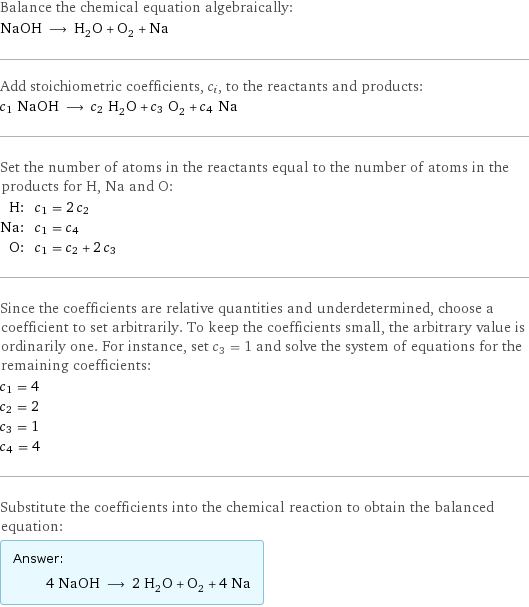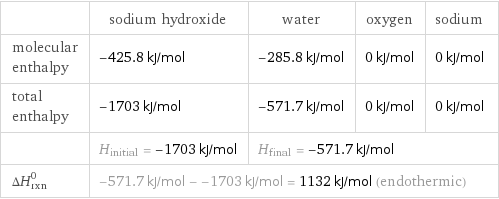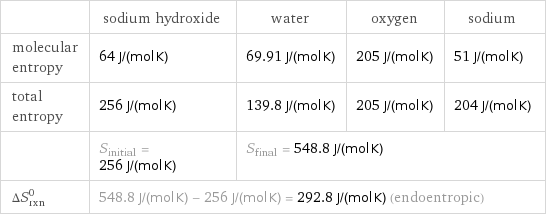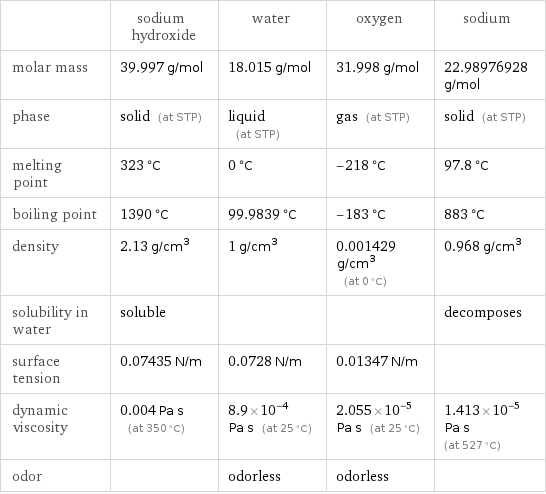Input interpretation

NaOH sodium hydroxide ⟶ H_2O water + O_2 oxygen + Na sodium
Balanced equation

Balance the chemical equation algebraically: NaOH ⟶ H_2O + O_2 + Na Add stoichiometric coefficients, c_i, to the reactants and products: c_1 NaOH ⟶ c_2 H_2O + c_3 O_2 + c_4 Na Set the number of atoms in the reactants equal to the number of atoms in the products for H, Na and O: H: | c_1 = 2 c_2 Na: | c_1 = c_4 O: | c_1 = c_2 + 2 c_3 Since the coefficients are relative quantities and underdetermined, choose a coefficient to set arbitrarily. To keep the coefficients small, the arbitrary value is ordinarily one. For instance, set c_3 = 1 and solve the system of equations for the remaining coefficients: c_1 = 4 c_2 = 2 c_3 = 1 c_4 = 4 Substitute the coefficients into the chemical reaction to obtain the balanced equation: Answer: | | 4 NaOH ⟶ 2 H_2O + O_2 + 4 Na
Structures

⟶ + +
Names

sodium hydroxide ⟶ water + oxygen + sodium
Reaction thermodynamics
Enthalpy

| sodium hydroxide | water | oxygen | sodium molecular enthalpy | -425.8 kJ/mol | -285.8 kJ/mol | 0 kJ/mol | 0 kJ/mol total enthalpy | -1703 kJ/mol | -571.7 kJ/mol | 0 kJ/mol | 0 kJ/mol | H_initial = -1703 kJ/mol | H_final = -571.7 kJ/mol | | ΔH_rxn^0 | -571.7 kJ/mol - -1703 kJ/mol = 1132 kJ/mol (endothermic) | | |
Entropy

| sodium hydroxide | water | oxygen | sodium molecular entropy | 64 J/(mol K) | 69.91 J/(mol K) | 205 J/(mol K) | 51 J/(mol K) total entropy | 256 J/(mol K) | 139.8 J/(mol K) | 205 J/(mol K) | 204 J/(mol K) | S_initial = 256 J/(mol K) | S_final = 548.8 J/(mol K) | | ΔS_rxn^0 | 548.8 J/(mol K) - 256 J/(mol K) = 292.8 J/(mol K) (endoentropic) | | |
Equilibrium constant
![Construct the equilibrium constant, K, expression for: NaOH ⟶ H_2O + O_2 + Na Plan: • Balance the chemical equation. • Determine the stoichiometric numbers. • Assemble the activity expression for each chemical species. • Use the activity expressions to build the equilibrium constant expression. Write the balanced chemical equation: 4 NaOH ⟶ 2 H_2O + O_2 + 4 Na Assign stoichiometric numbers, ν_i, using the stoichiometric coefficients, c_i, from the balanced chemical equation in the following manner: ν_i = -c_i for reactants and ν_i = c_i for products: chemical species | c_i | ν_i NaOH | 4 | -4 H_2O | 2 | 2 O_2 | 1 | 1 Na | 4 | 4 Assemble the activity expressions accounting for the state of matter and ν_i: chemical species | c_i | ν_i | activity expression NaOH | 4 | -4 | ([NaOH])^(-4) H_2O | 2 | 2 | ([H2O])^2 O_2 | 1 | 1 | [O2] Na | 4 | 4 | ([Na])^4 The equilibrium constant symbol in the concentration basis is: K_c Mulitply the activity expressions to arrive at the K_c expression: Answer: | | K_c = ([NaOH])^(-4) ([H2O])^2 [O2] ([Na])^4 = (([H2O])^2 [O2] ([Na])^4)/([NaOH])^4](../image_source/1c52421953a153f876039f6b6b2ec55e.png)
Construct the equilibrium constant, K, expression for: NaOH ⟶ H_2O + O_2 + Na Plan: • Balance the chemical equation. • Determine the stoichiometric numbers. • Assemble the activity expression for each chemical species. • Use the activity expressions to build the equilibrium constant expression. Write the balanced chemical equation: 4 NaOH ⟶ 2 H_2O + O_2 + 4 Na Assign stoichiometric numbers, ν_i, using the stoichiometric coefficients, c_i, from the balanced chemical equation in the following manner: ν_i = -c_i for reactants and ν_i = c_i for products: chemical species | c_i | ν_i NaOH | 4 | -4 H_2O | 2 | 2 O_2 | 1 | 1 Na | 4 | 4 Assemble the activity expressions accounting for the state of matter and ν_i: chemical species | c_i | ν_i | activity expression NaOH | 4 | -4 | ([NaOH])^(-4) H_2O | 2 | 2 | ([H2O])^2 O_2 | 1 | 1 | [O2] Na | 4 | 4 | ([Na])^4 The equilibrium constant symbol in the concentration basis is: K_c Mulitply the activity expressions to arrive at the K_c expression: Answer: | | K_c = ([NaOH])^(-4) ([H2O])^2 [O2] ([Na])^4 = (([H2O])^2 [O2] ([Na])^4)/([NaOH])^4
Rate of reaction
![Construct the rate of reaction expression for: NaOH ⟶ H_2O + O_2 + Na Plan: • Balance the chemical equation. • Determine the stoichiometric numbers. • Assemble the rate term for each chemical species. • Write the rate of reaction expression. Write the balanced chemical equation: 4 NaOH ⟶ 2 H_2O + O_2 + 4 Na Assign stoichiometric numbers, ν_i, using the stoichiometric coefficients, c_i, from the balanced chemical equation in the following manner: ν_i = -c_i for reactants and ν_i = c_i for products: chemical species | c_i | ν_i NaOH | 4 | -4 H_2O | 2 | 2 O_2 | 1 | 1 Na | 4 | 4 The rate term for each chemical species, B_i, is 1/ν_i(Δ[B_i])/(Δt) where [B_i] is the amount concentration and t is time: chemical species | c_i | ν_i | rate term NaOH | 4 | -4 | -1/4 (Δ[NaOH])/(Δt) H_2O | 2 | 2 | 1/2 (Δ[H2O])/(Δt) O_2 | 1 | 1 | (Δ[O2])/(Δt) Na | 4 | 4 | 1/4 (Δ[Na])/(Δt) (for infinitesimal rate of change, replace Δ with d) Set the rate terms equal to each other to arrive at the rate expression: Answer: | | rate = -1/4 (Δ[NaOH])/(Δt) = 1/2 (Δ[H2O])/(Δt) = (Δ[O2])/(Δt) = 1/4 (Δ[Na])/(Δt) (assuming constant volume and no accumulation of intermediates or side products)](../image_source/fbd08c42e802b171cdbb42fa981173a6.png)
Construct the rate of reaction expression for: NaOH ⟶ H_2O + O_2 + Na Plan: • Balance the chemical equation. • Determine the stoichiometric numbers. • Assemble the rate term for each chemical species. • Write the rate of reaction expression. Write the balanced chemical equation: 4 NaOH ⟶ 2 H_2O + O_2 + 4 Na Assign stoichiometric numbers, ν_i, using the stoichiometric coefficients, c_i, from the balanced chemical equation in the following manner: ν_i = -c_i for reactants and ν_i = c_i for products: chemical species | c_i | ν_i NaOH | 4 | -4 H_2O | 2 | 2 O_2 | 1 | 1 Na | 4 | 4 The rate term for each chemical species, B_i, is 1/ν_i(Δ[B_i])/(Δt) where [B_i] is the amount concentration and t is time: chemical species | c_i | ν_i | rate term NaOH | 4 | -4 | -1/4 (Δ[NaOH])/(Δt) H_2O | 2 | 2 | 1/2 (Δ[H2O])/(Δt) O_2 | 1 | 1 | (Δ[O2])/(Δt) Na | 4 | 4 | 1/4 (Δ[Na])/(Δt) (for infinitesimal rate of change, replace Δ with d) Set the rate terms equal to each other to arrive at the rate expression: Answer: | | rate = -1/4 (Δ[NaOH])/(Δt) = 1/2 (Δ[H2O])/(Δt) = (Δ[O2])/(Δt) = 1/4 (Δ[Na])/(Δt) (assuming constant volume and no accumulation of intermediates or side products)
Chemical names and formulas

| sodium hydroxide | water | oxygen | sodium formula | NaOH | H_2O | O_2 | Na Hill formula | HNaO | H_2O | O_2 | Na name | sodium hydroxide | water | oxygen | sodium IUPAC name | sodium hydroxide | water | molecular oxygen | sodium
Substance properties

| sodium hydroxide | water | oxygen | sodium molar mass | 39.997 g/mol | 18.015 g/mol | 31.998 g/mol | 22.98976928 g/mol phase | solid (at STP) | liquid (at STP) | gas (at STP) | solid (at STP) melting point | 323 °C | 0 °C | -218 °C | 97.8 °C boiling point | 1390 °C | 99.9839 °C | -183 °C | 883 °C density | 2.13 g/cm^3 | 1 g/cm^3 | 0.001429 g/cm^3 (at 0 °C) | 0.968 g/cm^3 solubility in water | soluble | | | decomposes surface tension | 0.07435 N/m | 0.0728 N/m | 0.01347 N/m | dynamic viscosity | 0.004 Pa s (at 350 °C) | 8.9×10^-4 Pa s (at 25 °C) | 2.055×10^-5 Pa s (at 25 °C) | 1.413×10^-5 Pa s (at 527 °C) odor | | odorless | odorless |
Units
